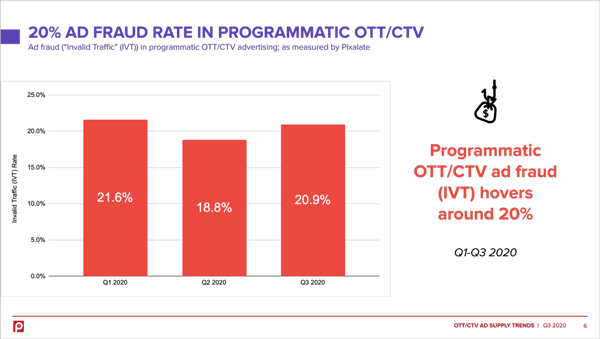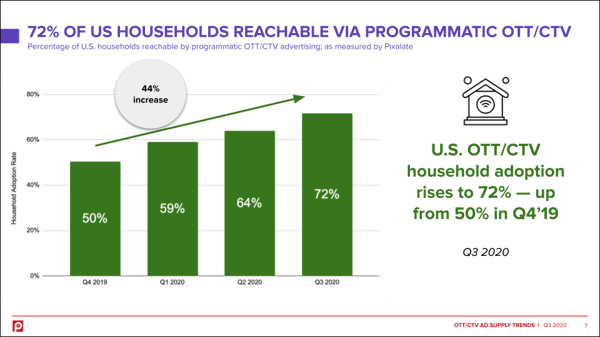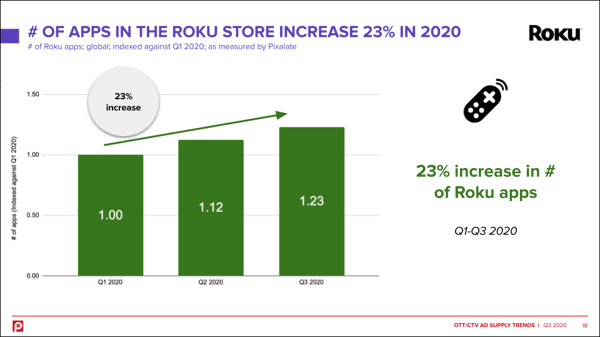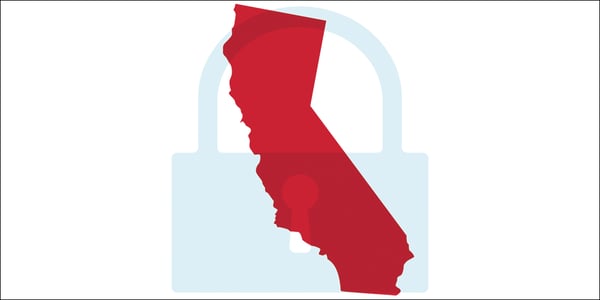
This week's review of ad fraud and quality in the digital advertising space.

This Pixalate blog post examines the invalid traffic (IVT) rate of global programmatic OTT/CTV advertising on a quarter-by-quarter basis in 2020, as detailed in Pixalate's Q3 2020 State of Connected TV/OTT: Ad Supply Trends Report. The data reveals that about 20% of programmatic OTT/CTV advertising is IVT.

This Pixalate blog post examines OTT/CTV U.S. household penetration by reviewing the percentage of U.S. households reachable via programmatic advertising on OTT/CTV devices on a quarter-by-quarter basis.
The data, which comes from Pixalate's Q3 2020 State of Connected TV/OTT: Ad Supply Trends Report, shows that 72% of U.S. households are now reachable via programmatic OTT/CTV advertising.

This Pixalate blog post reveals the growth of the Roku Channel Store in 2020 on a quarter-by-quarter basis, as well as the growth of Roku apps that support programmatic OTT/CTV advertising. The data comes from Pixalate's Q3 2020 State of Connected TV/OTT: Ad Supply Trends Report and reveals a 23% growth in apps on the Roku Channel Store.

eMarketer examines whether California's Privacy Protection Agency, which will be introduced in January 2021, could become a model for a federal data privacy agency. The California Privacy Protection Agency "will be the 'independent watchdog' responsible for enforcing California's new privacy laws and also educating businesses and consumers about these new rights and obligations," reported eMarketer.

"Black Friday is still a couple days away, but for ad-supported streaming services and connected TV platforms, this holiday advertising season is already its biggest, longest and busiest one ever," wrote Adweek, noting that "extended sales and [the] ecommerce boom [is driving] retailers to OTT channels."
*By entering your email address and clicking Subscribe, you are agreeing to our Terms of Use and Privacy Policy.
These Stories on Weekly Recaps
*By entering your email address and clicking Subscribe, you are agreeing to our Terms of Use and Privacy Policy.

Disclaimer: The content of this page reflects Pixalate’s opinions with respect to the factors that Pixalate believes can be useful to the digital media industry. Any proprietary data shared is grounded in Pixalate’s proprietary technology and analytics, which Pixalate is continuously evaluating and updating. Any references to outside sources should not be construed as endorsements. Pixalate’s opinions are just that - opinion, not facts or guarantees.
Per the MRC, “'Fraud' is not intended to represent fraud as defined in various laws, statutes and ordinances or as conventionally used in U.S. Court or other legal proceedings, but rather a custom definition strictly for advertising measurement purposes. Also per the MRC, “‘Invalid Traffic’ is defined generally as traffic that does not meet certain ad serving quality or completeness criteria, or otherwise does not represent legitimate ad traffic that should be included in measurement counts. Among the reasons why ad traffic may be deemed invalid is it is a result of non-human traffic (spiders, bots, etc.), or activity designed to produce fraudulent traffic.”

